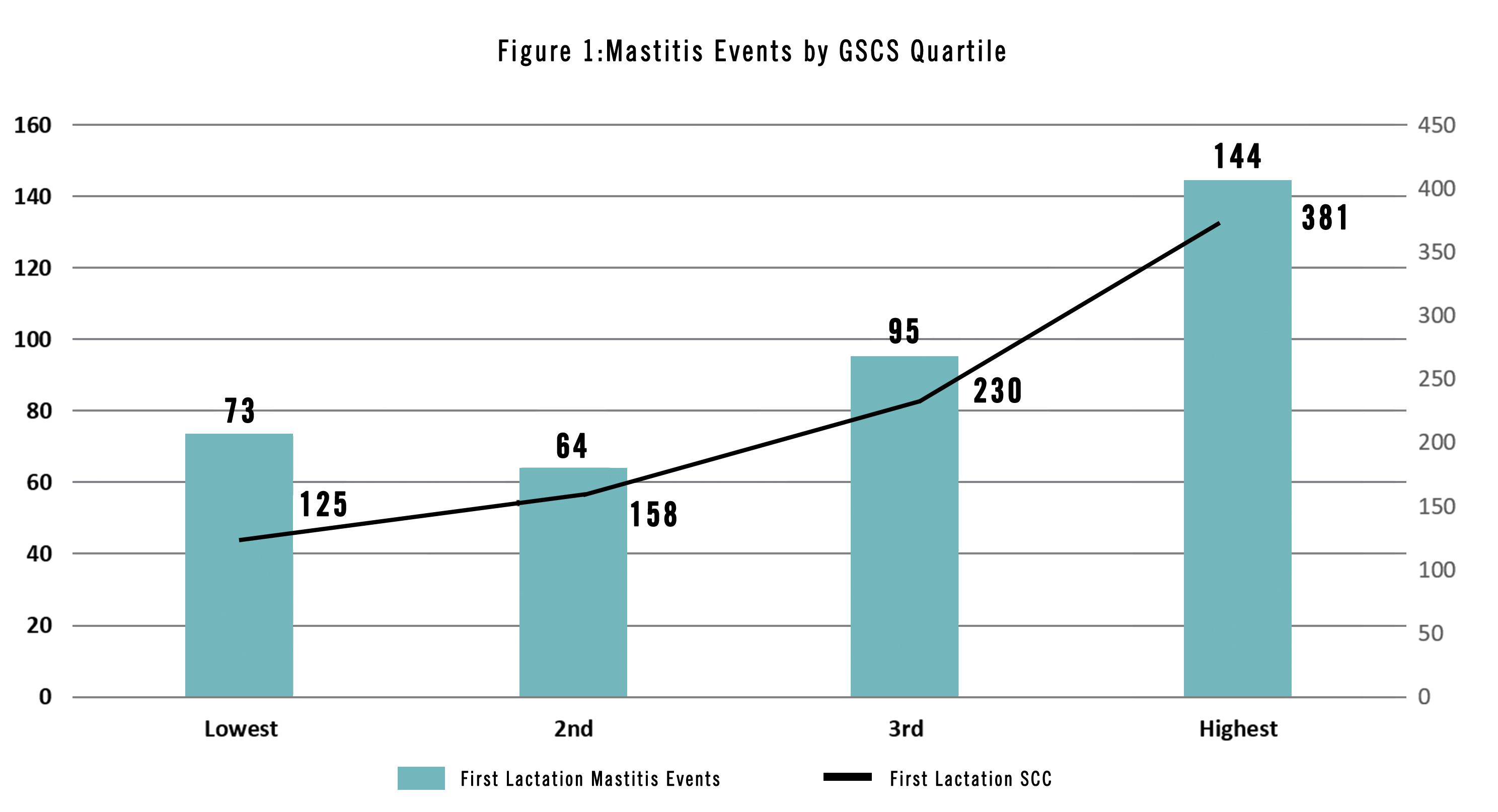There are three sources of information pertaining to mastitis in dairy cattle evaluations: Somatic Cell Score (SCS), CDCB Mastitis Resistance (MAST) and Zoetis Mastitis Resistance (Z MAST). In your genetic selection, look for sires with low SCS and high CDCB MAST and Zoetis Mastitis Resistance. When all three traits give the same signal, you can use those sires with confidence and reduce incidences of mastitis.
In herds with Somatic Cell Count (SCC) and mastitis records, you can see the economic impact of these traits. The quartile analysis graphs below represent a 3,500-cow dairy in the U.S.
Based on genomic data, Figure 1 shows that cows with lower genetic values for SCS are more than two times lower for average SCC and suffer fewer cases of mastitis than cows in the highest quartile for genomic SCS. When you factor in the cost of mastitis at $444* per cow, you can compare the savings for the lowest and highest quartile. The following audit summaries represent an average 2.74 GSCS in the lowest quartile and 3.09 GSCS in the highest quartile.
- First Lactation Cows: Lowest Quartile
- 65 cows with a mastitis event
- Total Cost = $28,860
- First Lactation Cows: Highest Quartile
- 118 mastitis events
- Total Cost = $52,392

Figure 2 references CDCB Mastitis data and shows that cows with higher genetic levels for this mastitis resistance trait are more than twice as low in average SCC. These cows exhibit fewer cases of mastitis than the cows in the lowest quartile for genomic CDCB Mastitis. Using $444 per cow, we can compare the economic impact of CDCB MAST for the lowest and highest quartile. In this audit summary, the lowest quartile averages -0.8 for GMAST and the highest quartile averages +2.4.
- First Lactation Cows: Lowest Quartile
- 135 cows with a mastitis event
- Total Cost = $59,940
- First Lactation Cows: Highest Quartile
- 44 cows with a mastitis event
- Total Cost = $19,536
When you compare the mastitis event totals for CDCB GMAST, the difference between the low and high quartiles is even greater than the genetic audit for SCS data. These insights reaffirm the legitimacy of the GMAST trait and show that it is a very effective tool for improving mastitis resistance.
Zoetis Mastitis Resistance is the third health and wellness trait tool available to genetically reduce mastitis events. The value is derived from Zoetis CLARIFIDE® Plus testing and factors into Zoetis wellness indexes. The wellness trait predictions from Zoetis are based on nearly 20 million health events from U.S. commercial dairies.
Let’s talk numbers
Surveys from National DHI and National Animal Health Monitoring Service list mastitis as the No. 3 reason for voluntary culling in commercial herds.
Mastitis costs U.S. dairy farmers an estimated $2 billion annually. For the global dairy industry, yearly expenses total $19.7 to $30 billion. Treatment of most clinical cases is less than 18 percent of the total cost of the disease. Treatment of clinical mastitis is expensive but the majority of the costs associated with a case of mastitis result from loss of production and other related, subsequent events:
- 31% milk yield losses
- 24% veterinarian and drugs
- 23% premature culling
- 18% discarded milk
- 4% Excess labor demand
Extended benefits
In addition to the economic benefits of mastitis resistant genetics, there are significant rewards in the consumer space. Consumers care about high-quality milk and they want confidence in the health and safety of dairy products. Udder health is a leading factor in determining milk quality. Genetic strides to reduce mastitis events will improve udder health, increase milk quality, and strengthen consumer trust.
*Mastitis cost reflects research cited in Preventative Veterinary Medicine, “The cost of clinical mastitis in the first 30 days of lactation: An economic modeling tool.”